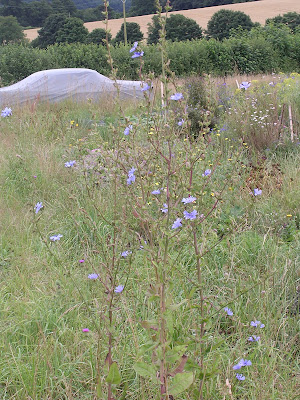I
know I bang on about wildflowers, but someone has to. They almost never feature on television
wildlife programmes but they’re just as important as fauna. None of us would be
here without them, and each variety has its niche.
Chicory
Frog,
Dog and I saw this uncommon plant yesterday while taking one of our regular routes
along the East Devon coast. I also see it from time to time in the organic
vineyard behind our house. According to the books it occurs on chalky soil (which
that at home definitely isn’t) – but what do the books know?
 |
| Chicory, along the East Devon coast, yesterday |
 |
| Chicory, a few years ago in the field behind the house (used for both growing vines and storing cars . . . ). It's a tall plant |
 |
| Chicory belongs to the Dandelion family and has the same square-ended petals as Cat's ear (mentioned in a previous post) |
Chicory's ground root used to be added to coffee to make it go further, and I remember my mother using ‘Camp coffee’, a sweetened liquid mixture of coffee and chicory, in her scrumptious coffee cake. Apparently chicory is now used on its own as a drink because it’s caffeine free (but what’s the point of that?).
Phacelia
While out and about on the edge of the Somerset Levels last month with Frog and Dog, I saw this plant on the edge of a field. It gave me a shock as I’d never seen it before, or anything like it, and it didn’t appear to belong to any plant family that I knew about. It was like seeing a Martian.
Back
home I emailed Plantlife, the wildflower charity to which I belong, and they
emailed back the following:
The plant is
Phacelia Phacelia tanacetifolia, an annual which is native to the
western US. It is widely planted on farmland as both a cover crop or green manure,
or as a nectar plant for insects. Once planted, it does sometimes persist for a
few years, and it can just pop up from spilled seed or bird feed, or as a
contaminant amongst other sown seed.
I was impressed with the answer (its detail and its speed) and encouraged to learn that I was right to see the
plant as an alien. I had heard of Phacelia, and had even kept a packet in the
cupboard for years waiting to use it as a green manure (but had never done so).
Flax
I do see this plant myself, but this year it was a local friend who brought it to my attention, emailing me a few weeks ago to ask what it was. (Very flattering!) |
| Photograph by Trish Currie |
It’s
a cultivated plant which sometimes ‘escapes’, used for linen and oil. Flax (flaxseed)
oil is the stuff we eat, and linseed oil goes into paints, the floor-covering lino
(linoleum) and cattle feed. I seem to remember that we also used linseed oil on our wooden rounders bats at school. It smelt like cucumber.
And here's a picture of a nearby flax field a few days ago.
There is a wild variety of Flax, with smaller flowers, called Pale Flax. It’s a rare plant, of chalky soils again, and I don’t think I’ve ever seen it.
And here's a picture of a nearby flax field a few days ago.
 |
| Photograph by Trish Currie |
There is a wild variety of Flax, with smaller flowers, called Pale Flax. It’s a rare plant, of chalky soils again, and I don’t think I’ve ever seen it.



I have the phacelia and flax in my garden, bees love both very much. By choice most of the flowers in my garden are blue and white.... except the ones that are pink..... but I'm working on that! Gardeners world are definitely leaning towards more naturalistic and bee friendly planting x
ReplyDeleteYour garden sounds lovely. I hadn't thought to use phacelia in the flower-beds! It's very striking so must look good. I do still find Gardeners' World behind the times (concentrating too much on alien flowers for me) but I love the current crop of viewers' films about their gardening.
ReplyDeleteAnother fascinating post - thank you B! I always wondered what Chicory was like - such a pretty flower - yes I've had it as a coffee substitute when I'm off caffeine - very boring - I prefer BarleyCup. And thanks for identifying Phacelia - we used to have masses of it on the allotment - in the asparagus bed - and I used have it in vases in the kitchen and gave bunches away to friends! xx
ReplyDeleteThank you Trish - for bothering to comment here and email! xx
ReplyDelete